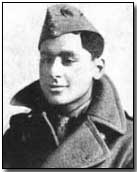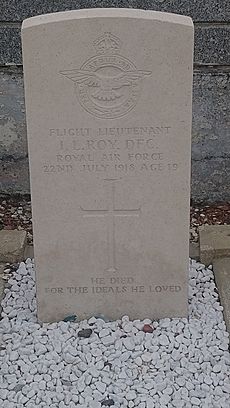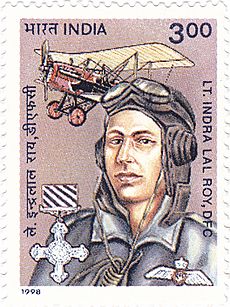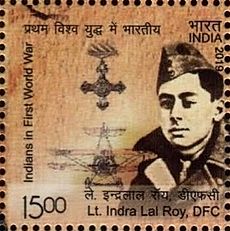Indra Lal Roy facts for kids
Quick facts for kids
Indra Lal Roy
|
|
|---|---|

Roy in his Royal Flying Corps uniform
|
|
| Native name |
ইন্দ্রলাল রায়
|
| Nickname(s) | "Laddie" |
| Born | 2 December 1898 Calcutta, British India |
| Died | 22 July 1918 (aged 19) Carvin, France |
| Buried |
Estevelles Communal Cemetery, Pas-de-Calais, France
(50°28′32″N 2°54′02″E / 50.47556°N 2.90056°E) |
| Allegiance | United Kingdom |
| Service/ |
|
| Years of service | 1917–1918 |
| Rank | Lieutenant |
| Unit | |
| Battles/wars |
|
| Awards | Distinguished Flying Cross |
| Relations |
|
Indra Lal Roy (born December 2, 1898 – died July 22, 1918) was an amazing pilot from India. He was the only Indian "flying ace" during World War I. A flying ace is a pilot who shoots down five or more enemy aircraft.
Roy flew for the Royal Flying Corps and later the Royal Air Force. He achieved ten victories in the air. This means he helped destroy or disable ten enemy planes. He did all this in just over 170 hours of flying time. Because of his bravery, he became the first Indian flying ace.
Contents
Roy's Family and Early Life
Indra Lal Roy was born in Calcutta, British India. His family was well-known and respected. His father, Piera Lal Roy, was a lawyer. Indra Lal was often called "Laddie" by his friends and family.
He had an older brother named Paresh Lal Roy. Paresh also served in the military. Later, he became famous as the "father of Indian boxing." Indra Lal's grandfather, Dr. Soorjo Coomar Goodeve Chuckerbutty, was one of the first Indian doctors trained in Western medicine. His nephew, Subroto Mukerjee, became the first Indian Chief of Air Staff for the Indian Air Force.
Joining the War Effort
When World War I began, Roy was a student in London, England. He wanted to join the Royal Flying Corps (RFC). However, he was first turned down because of his eyesight.
Roy didn't give up. He paid to see a top eye doctor, who said his eyesight was fine. So, the RFC changed their decision. On April 4, 1917, just after turning 18, he joined the RFC. He became a second lieutenant on July 5. After training, he joined No. 56 Squadron on October 30.
A Pilot's Challenges and Triumphs
On December 6, Roy had a serious accident. His S.E.5a fighter plane crashed. He was knocked out and thought to be dead. He even woke up in a French morgue!
While he was getting better, Roy drew many sketches of aircraft. Many of these drawings still exist today. In May, he was cleared to fly again. He then moved to No. 40 Squadron in June 1918.
After returning to duty, Roy achieved ten victories in just thirteen days. His first victory was on July 6. He shot down a German plane called a Hannover over Drocourt.
He had three victories on July 8 alone. He also shot down two planes on July 13 and two more on July 15. His last victory was on July 19. He shot down another Hannover C over Cagnicourt. Indra Lal Roy is believed to be the only Indian flying ace of World War I.
Sadly, Roy was killed on July 22, 1918. He was in a dog fight (air battle) over Carvin against German Fokker D.VII planes. He is buried in France.
List of Aerial Victories
| No. | Date/Time | Aircraft/ Serial No. |
Opponent | Result | Location | Notes |
|---|---|---|---|---|---|---|
| 1 | 6 July 1918 @ 0545 |
S.E.5a (B180) | Hannover C | Out of control | Drocourt | |
| 2 | 8 July 1918 @ 0645 |
S.E.5a (B180) | Hannover C | Out of control | Drocourt | |
| 3 | 8 July 1918 @ 0925 |
S.E.5a (B180) | Hannover C | Out of control | East of Monchy | Shared with Captain George McElroy and Lieutenant Gilbert Strange. |
| 4 | 8 July 1918 @ 1025 |
S.E.5a (B180) | Fokker D.VII | Out of control | South-east of Douai | |
| 5 | 13 July 1918 @ 0645 |
S.E.5a (B180) | Hannover C | Destroyed | West of Estaires | Shared with Captain George McElroy, and Lieutenants Gilbert Strange and F. H. Knobel. |
| 6 | 13 July 1918 @ 2005 |
S.E.5a (B180) | Pfalz D.III | Destroyed | Vitry — Brebières | |
| 7 | 15 July 1918 @ 2005 |
S.E.5a (B180) | Fokker D.VII | Destroyed | Hulloch | |
| 8 | Fokker D.VII | Out of control | ||||
| 9 | 18 July 1918 @ 2040 |
S.E.5a (B180) | DFW C.V | Destroyed | South-east of Arras | |
| 10 | 19 July 1918 @ 1025 |
S.E.5a (B180) | Hannover C | Destroyed | Cagnicourt |
Awards and Special Honours
After his death, Roy was given the Distinguished Flying Cross (DFC) in September 1918. This is a very important award for bravery in the air. He was the first Indian to ever receive the DFC.
The award recognized his actions from July 6 to July 19, 1918. The official statement said he was "a very gallant and determined officer." It also noted that he shot down nine enemy planes in just thirteen days. He showed amazing skill and courage, sometimes getting two planes in one flight.

In December 1998, India honored him with a special postage stamp. This was to mark 100 years since his birth. Indra Lal Roy is still remembered as a brave and skilled pilot.
See also
- Jogendra Nath Sen
- Karun Krishna Majumdar
- List of World War I flying aces from India



